Protea repens
| Botanical Name | Protea repens |
|||||||||||
| Family | Proteaceae - The Protea family
|
|||||||||||
| Pronunciation | PROH-tee-uh REE-penz |
|||||||||||
| Common Name(s) |
English: Common Sugarbush
Afrikaans: Suikerbos
IsiXhosa: isiqwane
|
|||||||||||
| Plant Group |
|
|||||||||||
| Plant Size |
|
|||||||||||
| Position |
|
|||||||||||
| General Information |
|
|||||||||||
| Specific Information | The Sugarbush Protea is an upright, low-branching shrub or small tree. It is one of the easiest to grow and a good species for the beginner. The pale green foliage consists of leathery, rather stiff leaves which deter most insects. The Sugarbush tolerates soils from heavy clay to deep white sand and will grow in near subtropical conditions to areas with some frost. It has a life-span of about 30 years and will flower four to five years from germination. The shrubs flower in summer or winter, depending on where they are grown, although I have found that my bushes are seldom without at least a flower or two. The copious amount of nectar produced by the flowers attracts birds, bees, beetles and other insects. This is a 'must have' addition to any garden within its tolerance range. |
|||||||||||
| Ad Break | ||||||||||||
| Flowers | ||||||||||||
| Description | flower heads are chalice-shaped with a collection of flowers in the center, surrounded by large colourful bracts |
|||||||||||
| Season |
|
|||||||||||
| Colour |
|
|||||||||||
| Growth Rate |
|
|||||||||||
| Plant Uses |
|
|||||||||||
| Distribution and Habitat | from the Bokkeveld Escarpment in the Western Cape Province to east of Grahamstown in the Eastern Cape Province, on flats, coastal facing slopes, lower and middle mountain slopes, scattered between other fynbos varieties or in dense stands |
|||||||||||
| Planting Suggestions | If growing Protea from seed, see this blog: http://kumbulanursery.co.za/blog/obtaining-and-growing-protea-seeds I am in the process of writing an article about growing and care of Protea and will include the link shortly. For the moment however, go to http://(http://finebushpeople.co.za for details about planting and care. Most Protea losses are due to fungal diseases and by the time you notice the plant is in stress, it is usually too late to do anything to save the plant. The best control is preventative: water plants early in the morning; keep soil surface cool by mulching; remove diseased plants immediately; do not over water in summer and never disturb the roots. Burn any diseased material. Stems bearing old flower heads should be cut back to encourage the development of new shoots and long stems. |
|||||||||||
| Medicinal Uses | Protea repens was used as a source of firewood as well as for the nectar produced by the flowers. The abundant nectar was collected and boiled into a sugary syrup called 'bossiestroop' (bush syrup', which was an essential component of 19th century medicine chests in the Cape. The collected juice was strained and boiled until the amber liquid formed a thick ruby-red syrup. The syrup was used for curing coughs and other chest complaints. |
|||||||||||
| Ad Break | ||||||||||||



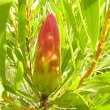
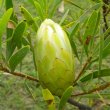
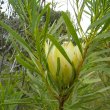
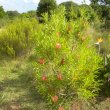
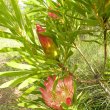


Comments
Protea Repens
Hi there just wanted to tell u, I have about 4 diff varieties of Protea Repens in my garden, they're gorgeous shrubs, I have protea repens Guerna, Embers, repens white and Rubens. Rubens being my favourite. I heard of Ice White and Honeyglow varieties as well, where can I find those two varieties? Any blues or maybe u guys have it? Lemme know please. Thanks guys and keep up the stunning work.
Protea repens hybrids
Hi Abdul
Rubens is stunning but Embers is also lovely. Sadly I have not been able to find a South African protea supplier so I can't help you. Perhaps you can get more information from finebushpeople.co.za, who sell protea and fynbos seeds. There must be growers in the Western Cape. If you find any, do let us know as we get many people asking for proteas and are unable to help.
Kind regards
Lorraine
protea seeds
You may find protea seeds on the website: bidorbuy.co.za. I bought some from a suppliers: Seedsforafrica
Protea seeds availability
Hi Elsa
Thanks for the tip. I get mine from Fine Bush People (finebushpeople.co.za) and I have found them very reliable.
My main problem is finding Protea growers who sell the plants, not only the cut flowers. Any suggestions?
Regards
Lorraine
Protea Farm sells plants
ODETTE WEEDON
Arnelia Farms
PO Box 192, Hopefield, 7355, South Africa
Tel / Fax +27 (0)22 723 1022
Cell +27 (0)72 197 6784
odette@arnelia.co.za www.arnelia.co.za
Protea plant sales
Hi William
Many thanks for your response. I had a look at their website and it has a list of the nurseries they supply across the country which will be most useful. I shall add this link in my protea blog as well.
Kind regards
Lorraine
Starting a small Protea orchard!
We are living on a 35 hectare portion at Kalkheuvel near Hartbeespoortdam and would appreciate help regarding past experiences of growing blooms in our area to augment our retirement venture!
Ant help out there...thanks regards
Protea Repens
We recently bought a Protea Farm with about 10 hectare of Protea Repens Bushes. We are also cultivating a small area of Repen Bushes for sale. Kind regards, Aletta Wilson
Well done and thanks
Great site. Thanks for the information.
Planting Proteas
Do proteas need to be planted in full sun or would partial shade be ok? We have morning sun areas that I would like to plant my proteas in.
Proteas in shade
Hi Sheila
As I have never had experience with this, I am unable to answer your query with any certainty but here is my opinion:
As with all sun-loving plants, your proteas are likely to become leggy and flowering will be negatively affected. If the plants are under the shade of other trees, you will need to be sure that they do not get too wet in summer (if you are not in a winter rain climate), that the plants get sufficient wind and that the area is not humid. Where these conditions are not met you have a recipe for the development of fungus growth - a death knell for proteas.
If you do decide to take the chance, do let me know of your results as my assessment may well be incorrect.
Perhaps another reader will be able to supply some first-hand information.
Kind regards
Lorraine
Planting Protea
Thank you for that Lorraine. I think the shade will pose a problem so will keep you posted.
Essential oil from ptotea plant material
I would like to know if you can extract essential oil from protea plant material? Know of anyone doing it at the moment?
Discuss this plant
Share knowledge, ask a question or give an experience.